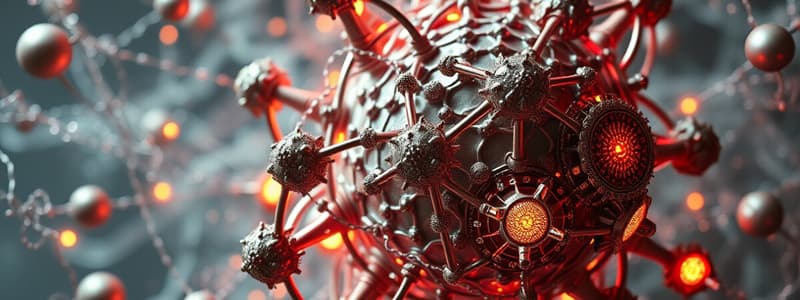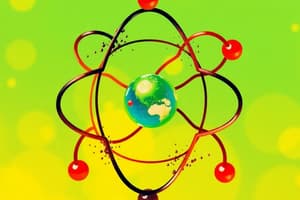Podcast
Questions and Answers
What is a primary similarity between science and a jigsaw puzzle?
What is a primary similarity between science and a jigsaw puzzle?
- Both require only one type of piece to understand.
- Both are only understood by experts in their fields.
- Both can be completed by a single individual quickly.
- Both involve assembling individual components to create a clearer picture. (correct)
What did Rutherford contribute to the understanding of the atom?
What did Rutherford contribute to the understanding of the atom?
- He showed that the Thomson model was incomplete. (correct)
- He was the first to identify the neutron.
- He discovered that electrons are identical to protons.
- He proposed that the nucleus contains only protons.
Why don't positively charged protons in the nucleus repel each other?
Why don't positively charged protons in the nucleus repel each other?
- Neutrons neutralize their charge.
- The nucleus is primarily made of electrons.
- They are too far apart in the nucleus.
- A strong nuclear force acts at very short distances. (correct)
Which model proposed that electrons are mixed with a positive core?
Which model proposed that electrons are mixed with a positive core?
What role do neutrons play in the atomic nucleus?
What role do neutrons play in the atomic nucleus?
What can be inferred about scientific discoveries based on the jigsaw puzzle analogy?
What can be inferred about scientific discoveries based on the jigsaw puzzle analogy?
Which of the following models advanced the understanding of the atomic nucleus by introducing the neutron?
Which of the following models advanced the understanding of the atomic nucleus by introducing the neutron?
What is the purpose of the strong nuclear force?
What is the purpose of the strong nuclear force?
Which physicist's experiments helped develop the understanding of the atomic nucleus?
Which physicist's experiments helped develop the understanding of the atomic nucleus?
How does the analogy of a jigsaw puzzle relate to research in science?
How does the analogy of a jigsaw puzzle relate to research in science?
The strong nuclear force is responsible for holding electrons together in the atomic nucleus.
The strong nuclear force is responsible for holding electrons together in the atomic nucleus.
The Rutherford model of the atom proposed that electrons are surrounded by a solid core.
The Rutherford model of the atom proposed that electrons are surrounded by a solid core.
Neutrons play no significant role in the atomic structure.
Neutrons play no significant role in the atomic structure.
Scientific discoveries can be seen as individual pieces of a jigsaw puzzle.
Scientific discoveries can be seen as individual pieces of a jigsaw puzzle.
The Thomson model correctly described the structure of the atomic nucleus.
The Thomson model correctly described the structure of the atomic nucleus.
Positively charged protons in the nucleus repel each other due to their like charges.
Positively charged protons in the nucleus repel each other due to their like charges.
Millikan's experiments helped clarify the model of the atomic nucleus.
Millikan's experiments helped clarify the model of the atomic nucleus.
The final understanding of atomic structure came about without the influence of multiple researchers.
The final understanding of atomic structure came about without the influence of multiple researchers.
Rutherford was the first to suggest that the atomic model consists of a small solid core.
Rutherford was the first to suggest that the atomic model consists of a small solid core.
After the discovery of protons and electrons, neutrons were discovered to further clarify the atomic model.
After the discovery of protons and electrons, neutrons were discovered to further clarify the atomic model.
Flashcards are hidden until you start studying
Study Notes
Science as a Jigsaw Puzzle
- Science is compared to a jigsaw puzzle where individual discoveries contribute to a larger understanding.
- Researchers make specific discoveries that, when compiled, enhance comprehension of processes or structures.
- Experiments by scientists like Crooke, Millikan, and Rutherford provided critical insights into the atomic nucleus.
Models of the Atom
- Early models attempted to depict atomic structure after discoveries of electrons and protons.
- The Thomson model proposed a positive core with electrons mixed throughout, aiming for electrical neutrality.
- Rutherford challenged the Thomson model, showing that the nucleus is a small solid core, allowing alpha particles to pass with minimal interaction.
- Post-Rutherford, the model evolved to depict protons and neutrons at the nucleus center, surrounded by electrons.
Discovery of the Neutron
- The introduction of the neutron completed the atomic model, solidifying the structure of the nucleus.
- Protons and neutrons are densely packed in the nucleus, with electrons in orbit around them.
Strong Nuclear Force
- Despite positive charges of protons potentially causing repulsion, a strong nuclear force is postulated to counteract this.
- The strong nuclear force operates at very short distances, overpowering the repulsive action of like charges.
- This force is crucial for the stability of the nucleus, ensuring that protons and neutrons are held together effectively.
Science as a Jigsaw Puzzle
- Science is compared to a jigsaw puzzle where individual discoveries contribute to a larger understanding.
- Researchers make specific discoveries that, when compiled, enhance comprehension of processes or structures.
- Experiments by scientists like Crooke, Millikan, and Rutherford provided critical insights into the atomic nucleus.
Models of the Atom
- Early models attempted to depict atomic structure after discoveries of electrons and protons.
- The Thomson model proposed a positive core with electrons mixed throughout, aiming for electrical neutrality.
- Rutherford challenged the Thomson model, showing that the nucleus is a small solid core, allowing alpha particles to pass with minimal interaction.
- Post-Rutherford, the model evolved to depict protons and neutrons at the nucleus center, surrounded by electrons.
Discovery of the Neutron
- The introduction of the neutron completed the atomic model, solidifying the structure of the nucleus.
- Protons and neutrons are densely packed in the nucleus, with electrons in orbit around them.
Strong Nuclear Force
- Despite positive charges of protons potentially causing repulsion, a strong nuclear force is postulated to counteract this.
- The strong nuclear force operates at very short distances, overpowering the repulsive action of like charges.
- This force is crucial for the stability of the nucleus, ensuring that protons and neutrons are held together effectively.
Studying That Suits You
Use AI to generate personalized quizzes and flashcards to suit your learning preferences.




